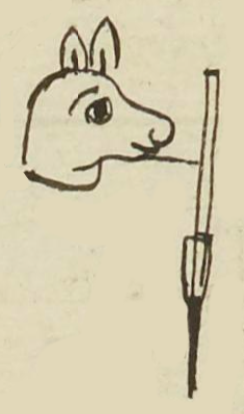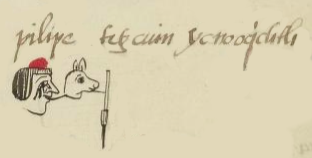Tetzcuin (MH896r)
This black-line drawing of the simplex glyph for the personal name Tetzcuin (perhaps “Stone-Dog” or maybe “Ugly Thing”) is attested here as a man’s name. The glyph shows the head of a white dog (an itzcuintli) in profile, looking right. A line from the dog’s mouth connects to a vertical, point-down, writing implement. This implement has some interesting detail that is not found on all such tools. There is nothing in the visuals here that suggests “stone” (tetl) or even an ugly deformed thing (tetzcuino). If this hieroglyph intends an apocopated tetzcuino, then the compound would be fully phonographic.
Stephanie Wood
If stone-dog is meant, perhaps the name refers to a stone carving of a dog. If tetzcuino (ugly or deformed thing) is meant, see a couple of examples of hieroglyphs below that seem to suggest some type of deformity. Perhaps surprisingly, having some kind of physical abnormality could have been a plus. Ben Leeming has written about people with deformities in Nahua culture as "morally neutral, supernaturally powerful, and ultimately essential members of the Mesoamerican sacred realm." [See: “‘Big-Old Long Lips’, ‘Big-Old Jar Nose’: Ancient Mesoamerican Monsters and Clowns and the Transformation of Christianity in Early Colonial Mexico," Ancient Mesoamerica 33:2 (Summer 2022).]
Stephanie Wood
pilipe tetzcuin, ycnooq~chtli
Felipe Tetzcuin, icnooquichtli
Stephanie Wood
1560
Jeff Haskett-Wood
diformes, piedras, perros, itzcuintles, cosas feas, nombres de hombres

tetzcuino, an ugly deformed thing, https://nahuatl.wired-humanities.org/content/tetzcuino
itzcuin(tli), a Mexican dog, https://nahuatl.wired-humanities.org/content/itzcuintli
te(tl), stone, https://nahuatl.wired-humanities.org/content/tetl
posiblemente, Piedra-Itzcuintli, o tal vez Cosa Fea
Stephanie Wood
Matrícula de Huexotzinco, folio 896r, World Digital Library, https://www.loc.gov/resource/gdcwdl.wdl_15282/?sp=864&st=image.
This manuscript is hosted by the Library of Congress and the World Digital Library; used here with the Creative Commons, “Attribution-NonCommercial-ShareAlike 3.0 License” (CC-BY-NC-SAq 3.0).




